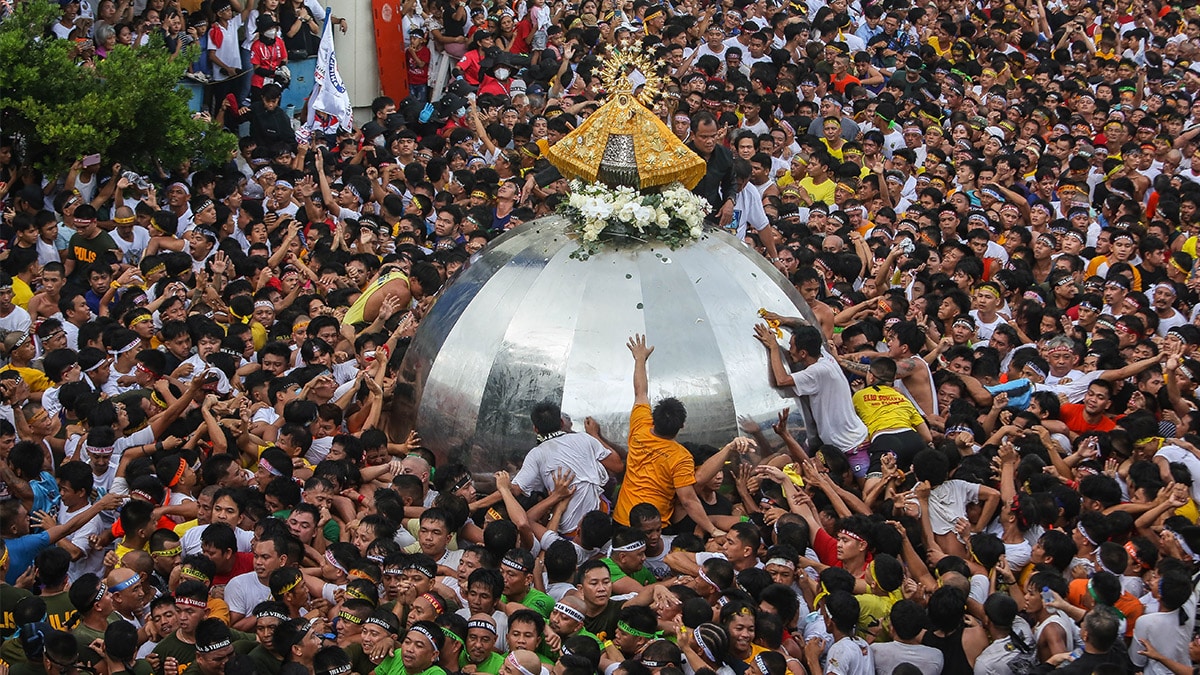
UNWAVERING FAITH Male devotees of Our Lady of Peñafrancia, locally known as “voyadores,” scramble up a silver dome to touch the Our Lady of Peñafrancia, locally revered as “Ina,” during the procession that marks the start of the weeklong centennial celebration of the coronation of Bicol’s patroness in Naga City. —MARK ALVIC ESPLANA
NAGA CITY, CAMARINES SUR, Philippines — In a grand display of faith and tradition, over a million devotees from across the country gathered to celebrate the 100th anniversary of the canonical coronation of Bicol’s patroness, Our Lady of Peñafrancia, in this city on Friday.
Clad in shirts and headbands bearing the slogan ‘Viva La Virgen’ (Long Live the Virgin), devotees took part in the traslacion, a revered procession that transports the images of the Virgin, locally called “Ina,” and the Divino Rostro (Holy Face) from the old Peñafrancia Shrine to the Naga Metropolitan Cathedral at the city center, signaling the start of the weeklong religious festival.
READ: Over 5,000 cops to secure Peñafrancia festival in Bicol
The male devotees, called “voyadores,” who are the only ones allowed within close proximity of Ina’s image during the traslacion, traditionally join barefooted, enduring the hours-long and physically challenging journey through the city’s main thoroughfares. Other pilgrims joined the procession from the sides of the streets or watched from a distance.
“We commemorate the centennial anniversary of Ina’s canonical coronation as Queen and Patroness of Bicolandia, which took place on Sept. 20, 1924,” Fr. Francis Tordilla, Director of the Caceres Commission on Communication told Inquirer in an interview on Friday.
The event reflects a medieval tradition of the Church where venerable images are seen as sacred, often attributed to miracles, and serve as potent vehicles for evangelization and devotion, Tordilla explained.
The devotion to Ina started in 1710 with Spanish priest Miguel Robles de Covarrubias, who had the image carved and housed in a chapel he had built in the city, then called Nueva Caceres.
Devotion transcends time
With the help of the natives, Covarrubias organized processions held in honor of the miraculous Virgin of Peñafrancia to honor the many favors he said to have received through her intercession. Since then, devotees and locals attributed miracles to the patroness.
The Bicol police estimated that more than one million devotees, including visitors from different provinces and countries, came to join the traslacion.
Luz Fabian, 76, who was a spectator at the procession with her grandchildren, said she was happy being part of the celebration.
“I feel guilty that I can’t join the procession because I’m too old and unable to walk, but what’s important is that I was able to see the image and express my strong faith by waving my handkerchief,” Fabian, a resident of Pili, Camarines Sur, said in an interview.
A Holy Mass followed the end of the procession at the Metropolitan Cathedral where thousands of devotees joined to pray.
Fluvial procession
A fluvial procession on the Naga River at the end of the novenary week will cap the feast on Sept. 21.
Following a farewell service at the Naga Metropolitan Cathedral, the images will be carried through the streets from the cathedral and then to be ensconced in a “pagoda” (a decorated shrine barge) that will cross the Naga River on the return journey to the Peñafrancia Basilica, where a Pontifical Mass will be held.
With the deployment of 5,000 uniformed personnel along the procession route, the traslacion was declared peaceful by Brig. Gen. Andre Dizon, Bicol police chief.